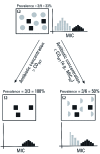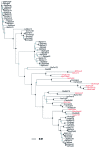Selective pressure of antibiotic pollution on bacteria of importance to public health
- PMID: 22571927
- PMCID: PMC3440082
- DOI: 10.1289/ehp.1104650
Selective pressure of antibiotic pollution on bacteria of importance to public health
Abstract
Background: Many bacteria of clinical importance survive and may grow in different environments. Antibiotic pollution may exert on them a selective pressure leading to an increase in the prevalence of resistance.
Objectives: In this study we sought to determine whether environmental concentrations of antibiotics and concentrations representing action limits used in environmental risk assessment may exert a selective pressure on clinically relevant bacteria in the environment.
Methods: We used bacterial inhibition as an assessment end point to link antibiotic selective pressures to the prevalence of resistance in bacterial populations. Species sensitivity distributions were derived for three antibiotics by fitting log-logistic models to end points calculated from minimum inhibitory concentration (MIC) distributions based on worldwide data collated by the European Committee on Antimicrobial Susceptibility Testing (EUCAST). To place bacteria represented in these distributions in a broader context, we performed a brief phylogenetic analysis. The potentially affected fraction of bacterial genera at measured environmental concentrations of antibiotics and environmental risk assessment action limits was used as a proxy for antibiotic selective pressure. Measured environmental concentrations and environmental risk assessment action limits were also directly compared to wild-type cut-off values.
Results: The potentially affected fraction of bacterial genera estimated based on antibiotic concentrations measured in water environments is ≤ 7%. We estimated that measured environmental concentrations in river sediments, swine feces lagoons, liquid manure, and farmed soil inhibit wild-type populations in up to 60%, 92%, 100%, and 30% of bacterial genera, respectively. At concentrations used as action limits in environmental risk assessment, erythromycin and ciprofloxacin were estimated to inhibit wild-type populations in up to 25% and 76% of bacterial genera.
Conclusions: Measured environmental concentrations of antibiotics, as well as concentrations representing environmental risk assessment action limits, are high enough to exert a selective pressure on clinically relevant bacteria that may lead to an increase in the prevalence of resistance.
Conflict of interest statement
The authors declare they have no actual or potential competing financial interests.
Figures





Comment in
-
Preventing antibiotic resistance in the wild: a new end point for environmental risk assessment.Environ Health Perspect. 2012 Aug;120(8):a321. doi: 10.1289/ehp.120-a321a. Environ Health Perspect. 2012. PMID: 22853922 Free PMC article. No abstract available.
References
-
- Agersø Y, Wulff G, Vaclavik E, Halling-Sørensen B, Jensen LB. Effect of tetracycline residues in pig manure slurry on tetracycline-resistant bacteria and resistance gene tet(M) in soil microcosms. Environ Int. 2006;32:876–882. - PubMed
-
- Bonfiglio G, Livermore DM. Effect of media composition on the susceptibility of Xanthomonas mahophilia to β-lactam antibiotics. J Antimicrob Chemother. 1991;28:837–842. - PubMed
-
- Butler T, Frenck RW, Johnson RB, Khakhria R. In vitro effects of azithromycin on Salmonella typhi: early inhibition by concentrations less than the MIC and reduction of MIC by alkaline pH and small inocula. J Antimicrob Chemother. 2001;47:455–458. - PubMed
-
- Chander Y, Kumar K, Goyal SM, Gupta SC. Antibacterial activity of soil-bound antibiotics. J Environ Qual. 2005;34:1952–1957. - PubMed
Publication types
MeSH terms
Substances
LinkOut - more resources
Full Text Sources
Other Literature Sources
Molecular Biology Databases

